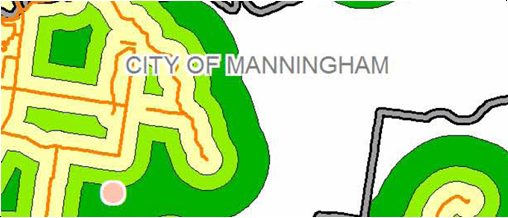This study built on previous work by ViaStrada with assistance at different stages by Beca and MWH. The premise is that a cycle route provides a certain level of service to potential users if it lies within a certain distance of them, whether they be residents at their homes, school or university students at their schools or people at work. Cycle routes should be provided first in areas of highest "demographic density" to achieve the "best bang for the buck". Buffer sizes of 400 m, 800 m and 1,600 m were evaluated in a GIS using "demographic coverage" as a measure of the effectiveness of different buffer sizes.
The study showed that 74% of Melbourne people (residents, employees and students) are within 800 m "as the crow flies" of the existing Principal Bicycle Network (PBN). This "demographic coverage" figure rises to 92% within 800 m of the future (planned) PBN. In addition, a number of recommendations were made, including:
- An 800 m buffer is generally recommended as a policy tool for the provision of the Principal Bicycle Network (PBN). This corresponds to a spacing of 1,600 m between parallel routes. Further work is recommended to compare "crow flies" and actual travel distances from the edge of the buffer to the PBN.
- A closer spacing of the routes of the PBN (a smaller "grain size") is recommended for the Melbourne CBD because of the very high demographic densities there.

